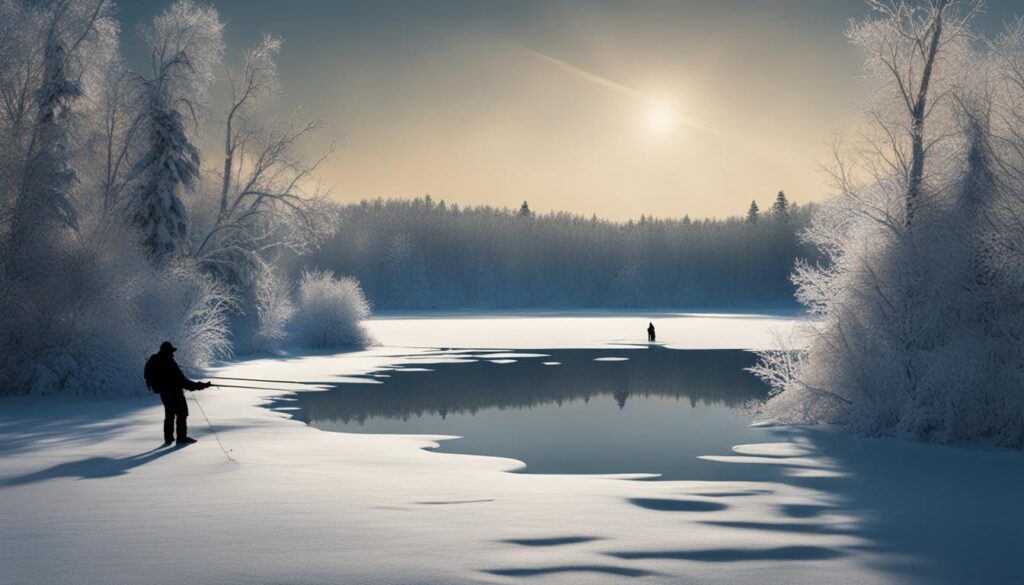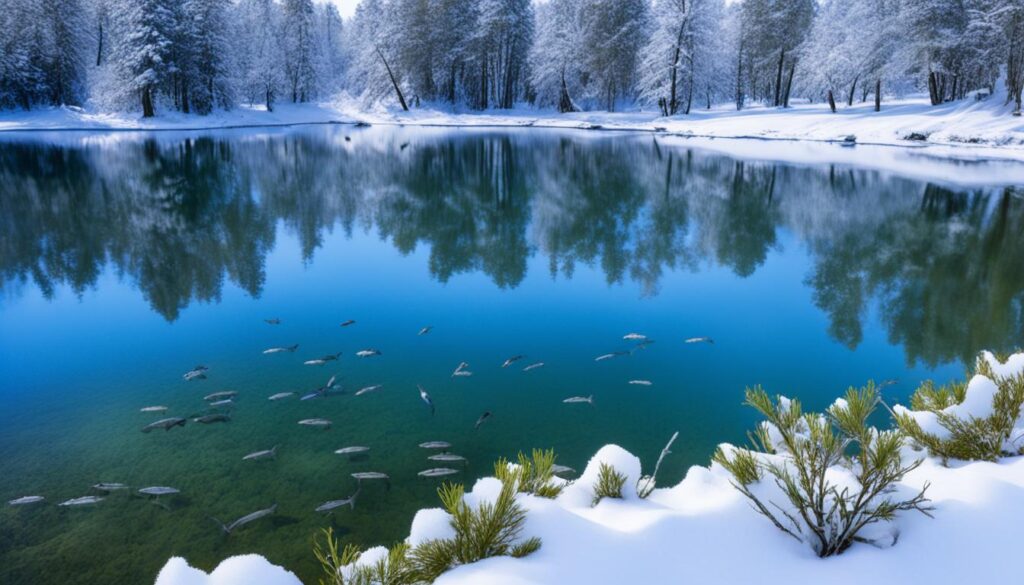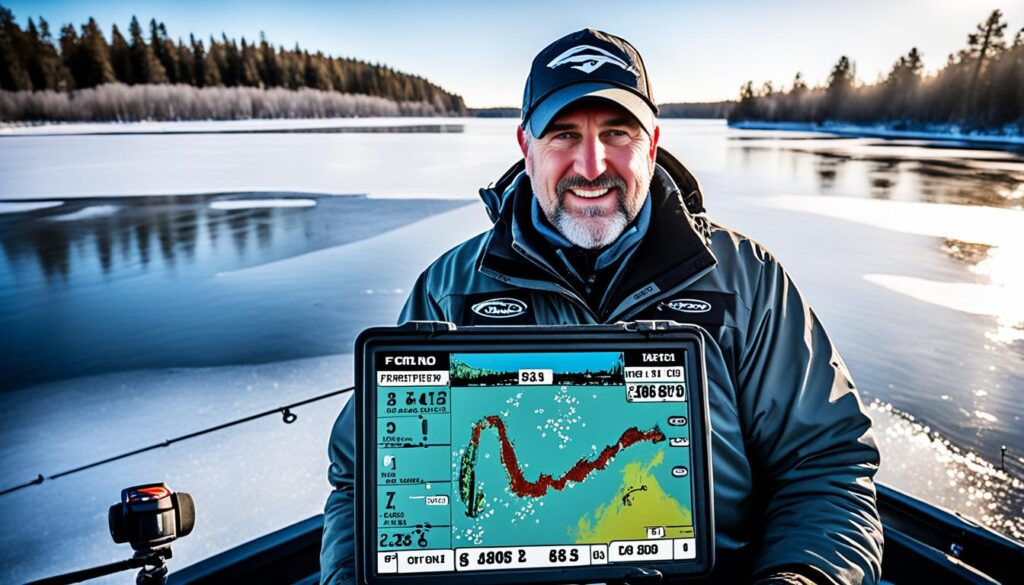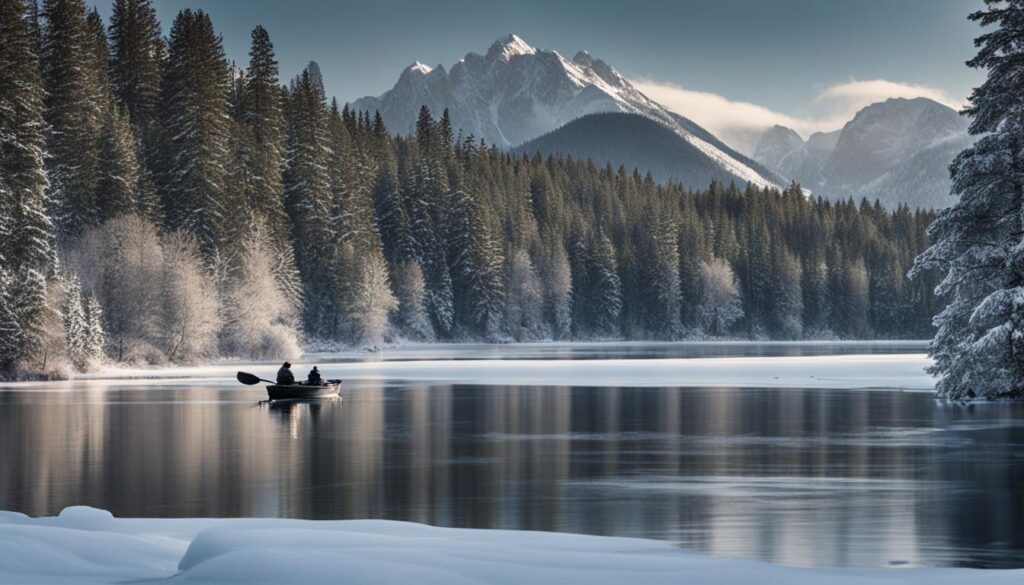Are you ready to reel in trophy bass this winter? While it may require a different approach than fishing in other seasons, winter bass fishing can be incredibly rewarding. To increase your chances of success, it’s important to know the best fishing locations and optimal fishing times for bass during the winter months. In this article, we will unveil the secret winter bass hotspots and provide valuable insights on when to fish them.
Angler’s Essentials:
- Winter bass fishing requires a different approach than other seasons.
- Knowing the best fishing locations and optimal fishing times is crucial.
- Understanding water temperature and fish behavior is key to success in winter bass fishing.
- Safety and preparation should be prioritized when venturing out on cold water.
- Utilizing electronics and selecting the right lures are important factors in winter bass fishing.
Safety and Preparation for Winter Bass Fishing
When it comes to winter bass fishing, safety should always be a top priority. Cold water can be hazardous, so it’s crucial to take the necessary precautions before heading out on the water. In this section, we will discuss the essential winter fishing techniques and preparation tips that will help you stay safe and maximize your success.
Staying Safe in Cold Water
- Inform someone of your fishing plans and expected return time. This ensures that someone is aware of your whereabouts and can alert authorities if necessary.
- Dress in layers to stay warm. Layering allows you to adjust your clothing according to the changing weather conditions.
Winter Fishing Techniques
Winter bass fishing requires specific techniques to entice the fish in colder waters. Here are some tips to improve your chances of landing a bass:
- Use slow-moving baits: Winter bass are less active, so opt for lures that mimic a slow-moving meal. Jigs, soft plastics, and blade baits are excellent choices.
- Vary your retrieve: Experiment with different retrieve speeds and pauses to find what triggers a bite. In colder water, bass tend to strike on slower presentations.
- Fish deeper water: During winter, bass often move to deeper areas where the water temperature is more stable. Target underwater structure and areas with significant depth changes when searching for bass.
By implementing these winter fishing techniques and focusing on safety, you’ll be well-prepared for a successful and enjoyable bass fishing experience in the colder months.
| Preparation Tips for Winter Bass Fishing |
|---|
| Dress in warm and waterproof clothing. |
| Wear appropriate headgear and gloves to protect against the cold. |
| Bring extra layers and hand warmers in case the weather changes. |
| Ensure your boat and fishing gear are in good working condition. |
| Always have a fully charged cell phone and a means of communication in case of emergencies. |
Finding the Best Fishing Locations for Winter Bass
When it comes to winter bass fishing, finding the best fishing locations is crucial for a successful day on the water. Understanding the behavior of bass during the winter months and knowing where they are likely to be can make all the difference.
Two key factors to consider when searching for the best fishing spots are baitfish and deep water. Bass in winter tend to congregate around areas that provide a steady food source, and baitfish are their primary target. By locating areas with abundant baitfish, you increase your chances of finding active bass.
Deep water is another important factor to consider. Bass in winter tend to move to deeper areas where the water is more stable and warmer. Deep-water areas provide a refuge for bass during the colder months.
Best Winter Bass Fishing Spots
Here are some of the best bass fishing spots to target during the winter:
- Humps: Submerged humps are ideal spots to find winter bass. These underwater structures provide a change in depth and are often hotspots for baitfish as well.
- Underwater Islands: Similar to humps, underwater islands attract baitfish and, in turn, bass. These structures can be found near points or along drop-offs.
- Long Points: Long points extending into deeper water are another favorite winter habitat for bass. These areas provide easy access to deep water and are often prime feeding grounds.
Understanding fish behavior and considering their movement during other seasons can also help identify prime winter bass locations. By knowing where bass are likely to be during different times of the year, you can target similar areas in winter.
Take advantage of your knowledge of seasonal fish movement, combined with the key factors of baitfish and deep water, to locate the best fishing spots for winter bass.

| Prime Winter Bass Fishing Spots | Description |
|---|---|
| Humps | Submerged humps are underwater structures that attract baitfish and winter bass. |
| Underwater Islands | Underwater islands located near points or along drop-offs are ideal spots to find bass in winter. |
| Long Points | Long points extending into deeper water are prime feeding grounds for winter bass. |
Lure Selection for Winter Bass Fishing
When it comes to winter bass fishing, the key to success lies in choosing the right lures. In the cold winter months, fast-moving and topwater baits are not as effective as they are during other seasons. Instead, bottom-hugging baits and slow-moving lures are preferred to entice lethargic winter bass.
Jigs, spoons, and blade baits are among the most effective choices for winter bass fishing. Jigs, in particular, excel at imitating bottom-dwelling prey such as crawfish and baitfish. They can be worked slowly along the bottom, mimicking the natural movement of injured or sluggish prey. This entices bass to strike, even in the colder water temperatures.
For a more finesse approach, consider using soft plastics on a drop-shot rig. This setup allows you to present the bait close to the bottom, right in front of the bass’s face. The slow, subtle movements of the soft plastics can trigger a response from even the most stubborn winter bass.
Color selection is also crucial when choosing lures for winter bass fishing. Opt for colors that mimic the local baitfish and crawfish. Natural colors like green pumpkin, black and blue, and watermelon are excellent choices for imitating the prey in your area.
Remember, winter bass are less active and require a tempting meal to strike. By selecting the best winter bass fishing baits, such as jigs, spoons, blade baits, and soft plastics on a drop-shot rig, you can increase your chances of enticing those sluggish bass to bite.
| Lure Type | Description |
|---|---|
| Jigs | Bottom-hugging bait that imitates crawfish and baitfish. Worked slowly along the bottom. |
| Spoons | Metal bait that can be jigged vertically or retrieved slowly. Mimics injured baitfish. |
| Blade Baits | Compact metal lure with a vibrating action. Can be fished vertically or retrieved slowly. |
| Soft Plastics | Used on a drop-shot rig to present the bait close to the bottom. Mimics natural prey movements. |
Understanding Water Temperature for Winter Bass Fishing
Water temperature plays a critical role in determining bass behavior during the winter months. By understanding how bass react to different water temperatures, anglers can increase their chances of success on the water. Let’s explore the key water temperature triggers for bass and the optimal water temperatures for winter bass fishing.
Water Temperature and Bass Behavior
The behavior of bass is closely linked to water temperature. As the water cools down, bass become less active and more sluggish. In water below 40 degrees Fahrenheit, bass are less likely to chase down fast-moving baits and may require an easy meal to entice a strike.
When the water temperature is in the 40 to 50-degree range, bass are still actively feeding and will bite a variety of baits. This is a prime time to target winter bass using slow-moving lures such as jigs, spoons, and blade baits.
As the water temperature rises into the 50 to 60-degree range, bass are transitioning between seasons. They become more active and are willing to bite a wide range of lures. This is a great opportunity to experiment with different presentations and find what works best on any given day.
Optimal Water Temperatures for Winter Bass Fishing
While bass can be caught in a wide range of water temperatures during the winter, there are certain temperature ranges that tend to be more productive. Water temperatures in the 40 to 50-degree range are considered ideal for winter bass fishing. Bass are actively feeding during this time and are likely to be found in their winter haunts.
Here is a breakdown of the optimal water temperatures for winter bass fishing:
| Water Temperature Range (Fahrenheit) | Bass Behavior | Suggested Lures |
|---|---|---|
| Below 40 | Less active, requires easy meal | Jigs, spoons, blade baits |
| 40-50 | Actively feeding, bites a variety of baits | Slow-moving lures, jigs, soft plastics |
| 50-60 | Transitioning between seasons, willing to bite a wide range of lures | Variety of lures, experiment with presentations |
Understanding water temperature and its impact on bass behavior is key to a successful winter bass fishing trip. By targeting the optimal water temperatures and adjusting your lure selection accordingly, you can increase your chances of landing a trophy bass during the winter months.

Utilizing Electronics in Winter Bass Fishing
Winter bass fishing can be a challenging endeavor, but with the right tools, it becomes much more manageable. One of the most valuable pieces of equipment you can use during the winter season is a fish finder. These electronic devices are especially useful in helping you locate and target bass in colder waters.

When you’re out on the water, scanning areas with your fish finder while idling your boat can provide valuable information about the underwater landscape and the presence of baitfish. Understanding where the baitfish are located is key to finding the bass, as they tend to follow their prey.
Dropping baits vertically to the fish you see on your fish finder is an effective approach in winter fishing. The bass may be hugging the bottom, so using metal baits like spoons and drop-shot rigs can be worked vertically to target winter bass. This presentation allows you to present your bait at the same depth as the fish, increasing your chances of a strike.
In addition to locating bass, fish finders can also help you identify other underwater structures that may attract and hold bass in winter. This includes submerged timber, rock piles, and drop-offs. By surveying the area with your fish finder, you can pinpoint these spots and focus your fishing efforts accordingly.
Remember, fish finders are just one tool in your arsenal. It’s important to combine their capabilities with your knowledge of winter bass fishing techniques and understanding of fish behavior. By utilizing electronics and other strategies, you can enhance your winter bass fishing experience and increase your chances of landing that trophy-sized fish.
The Importance of Hard Structure for Winter Bass Fishing
Fishing for winter bass requires a strategic approach, and one key element to consider is the presence of hard structure in your fishing areas. Hard structure such as riprap, bridge pilings, and docks plays a vital role in attracting and holding winter bass. Understanding the importance of hard structure and its connection to deep water and bass location in winter can greatly enhance your success on the water.
During the winter months, bass seek refuge in areas that provide protection and a comfortable environment. Hard structure, with its dense composition and irregular shapes, creates hiding spots for bass to ambush prey and conserve energy. The bass are naturally drawn to these man-made or natural structures, making them prime locations for targeting winter bass.
The Benefits of Hard Structure in Winter Bass Fishing
Hard structure acts as a heat source, absorbing and radiating warmth into the surrounding water. This temperature differential attracts baitfish, which in turn attracts bass. By focusing your efforts around hard structure, you increase your chances of finding active and feeding winter bass.
In addition to providing warmth and attracting baitfish, hard structure also serves as a congregation point for bass. The irregular contours and crevices provide ample hiding spaces for bass to seek shelter and wait for passing prey. By presenting your baits near or around the structure, you can entice even the most lethargic winter bass to strike.
Deep Water and Bass Location in Winter
When selecting winter bass fishing spots, it’s crucial to consider the proximity to deep water. Bass tend to seek out deeper areas during winter, as it provides a stable and consistent environment. The deep water acts as a refuge from temperature fluctuations and offers a steady supply of food for the bass. Hard structure located near deep water is particularly productive, as it serves as a transition zone where bass can move between shallow and deep areas easily.
East-facing hard structure is especially advantageous for winter bass fishing. These structures receive the earliest exposure to the winter sun, which can slightly increase the water temperature and stimulate bass activity. Conversely, west-facing structures retain warmth throughout the night, offering a more stable and comfortable environment for the bass.
| Advantages of Hard Structure for Winter Bass Fishing | Key Considerations |
|---|---|
| Attracts baitfish | Proximity to deep water |
| Provides hiding spots for ambushing prey | Orientation to the sun |
| Serves as a heat source | Transition zone for bass movement |
By understanding the importance of hard structure and its relationship to deep water and bass location in winter, you can effectively target and catch winter bass. Incorporate baits and techniques that capitalize on the unique dynamics of fishing around hard structure, such as crankbaits, jerkbaits, or jigs. Experiment with different presentations and be patient, as winter bass can be more finicky and require slower, more enticing movements to provoke a strike.
Winter Bass Fishing Techniques and Baits for Hard Structure
Crankbaits and jerkbaits are two popular lure choices for fishing hard structure in the winter. When targeting bass around hard structure such as riprap, bluff walls, and bridge pilings, using squarebill crankbaits and suspending jerkbaits can yield great results.
With their realistic swimming action and diving capabilities, crankbaits mimic injured or fleeing baitfish, enticing bass to strike. The squarebill design allows the lure to bounce off rocks and other underwater structures without snagging, making it ideal for fishing around hard structure. Consider using crankbaits with natural colors and patterns that resemble local baitfish, such as shad or bluegill.
Jerkbaits, on the other hand, excel in imitating a wounded baitfish or a dying shad struggling near the surface. The suspending jerkbait’s ability to suspend at a particular depth allows anglers to work it effectively around hard structure, giving winter bass a tempting target. The erratic and twitchy action of jerkbaits can trigger reaction strikes from lethargic winter bass.
Techniques for Fishing Hard Structure in Winter
When fishing with crankbaits and jerkbaits around hard structure in winter, it’s important to slow down your presentations. The cold water temperatures make bass less active, so a more methodical approach is necessary to entice them.
“The key to success with crankbaits and jerkbaits in the winter is to make slow presentations and incorporate long hesitations between twitches. This mimics the behavior of paralyzed or weakened baitfish, making the bass more likely to strike.”
In addition to crankbaits and jerkbaits, jigs and shaky head worms are also effective for bottom-oriented fishing around hard structure. These lures can be presented slowly along the bottom, enticing bass that are holding near the structure. Consider using jigs in natural colors such as brown or green pumpkin, and shaky head worms in colors that imitate worms or crawfish.
Recommended Baits for Fishing Hard Structure in Winter
| Bait Type | Recommended Options |
|---|---|
| Crankbaits | Squarebill crankbaits in natural colors |
| Jerkbaits | Suspending jerkbaits in realistic colors |
| Jigs | Brown or green pumpkin jigs |
| Shaky Head Worms | Worm or crawfish-colored shaky head worms |
By using these techniques and baits, you can increase your chances of catching winter bass around hard structure. Remember to adjust your presentations to the slower-paced behavior of the bass during the winter months. Happy fishing!
Conclusion
Winter bass fishing can be a rewarding and exhilarating experience for anglers who adopt the right approach and techniques. By taking into consideration essential factors like safety, fish behavior, location selection, lure choice, water temperature, and utilizing electronics, you can significantly increase your chances of success on the water.
Prioritizing safety should always be the first step. Dressing in layers, letting someone know your fishing plans, and being prepared for changing weather conditions are crucial for a safe and enjoyable fishing trip.
Understanding the behavior of bass in winter and locating the best fishing spots is key to a successful outing. Fish tend to seek deeper water and hard structures, such as riprap and bridge pilings. Utilize fish finders to scan and locate baitfish and bass in these areas.
When it comes to lure selection, opt for slow-moving baits like jigs, spoons, and blade baits. Mimic local baitfish and crawfish with your color selection. Pay attention to water temperature, as it influences bass activity and their preference for certain baits.
In conclusion, with the right knowledge and preparation, winter bass fishing can be a thrilling and productive experience. Remember to stay safe, choose the right locations and lures, monitor water temperature, and use electronics to your advantage. Happy fishing!
FAQ
Is winter a good time to catch trophy bass?
Yes, winter is a great time to catch trophy bass, but it requires a different approach.
What safety precautions should I take while winter bass fishing?
It’s essential to prioritize safety during winter bass fishing. Dress in layers, let someone know your fishing plans, and be prepared for changing conditions.
Where can I find the best fishing locations for winter bass?
Look for humps, underwater islands, and long points. Understanding fish behavior and considering their movement during other seasons can also help identify prime winter bass locations.
What types of lures should I use for winter bass fishing?
Slow-moving lures such as jigs, spoons, and blade baits are preferred in winter. Soft plastics on a drop-shot rig are also effective. Color selection should mimic local baitfish and crawfish.
How does water temperature affect bass behavior in winter?
Water temperature is crucial. Bass in water below 40 degrees Fahrenheit are less active, while those in the 40 to 50-degree range are still feeding. Bass in the 50 to 60-degree range are transitioning between seasons.
How can I use electronics for winter bass fishing?
Use fish finders to scan areas for baitfish and nearby bass. Dropping baits vertically to the fish you see on your fish finder is an effective approach.
Why is hard structure important for winter bass fishing?
Hard structure, such as riprap, bridge pilings, and docks, act as a heat source and attract baitfish and bass. Proximity to deep water is also important.
What baits and techniques work well for fishing hard structure in winter?
Crankbaits, jerkbaits, jigs, and shaky head worms are popular choices. Slow presentations and long hesitations between twitches are key for enticing lethargic winter bass.
Any final tips for winter bass fishing success?
Prioritize safety, understand fish behavior, choose the right locations and lures, pay attention to water temperature, and utilize electronics for the best chance of success.
